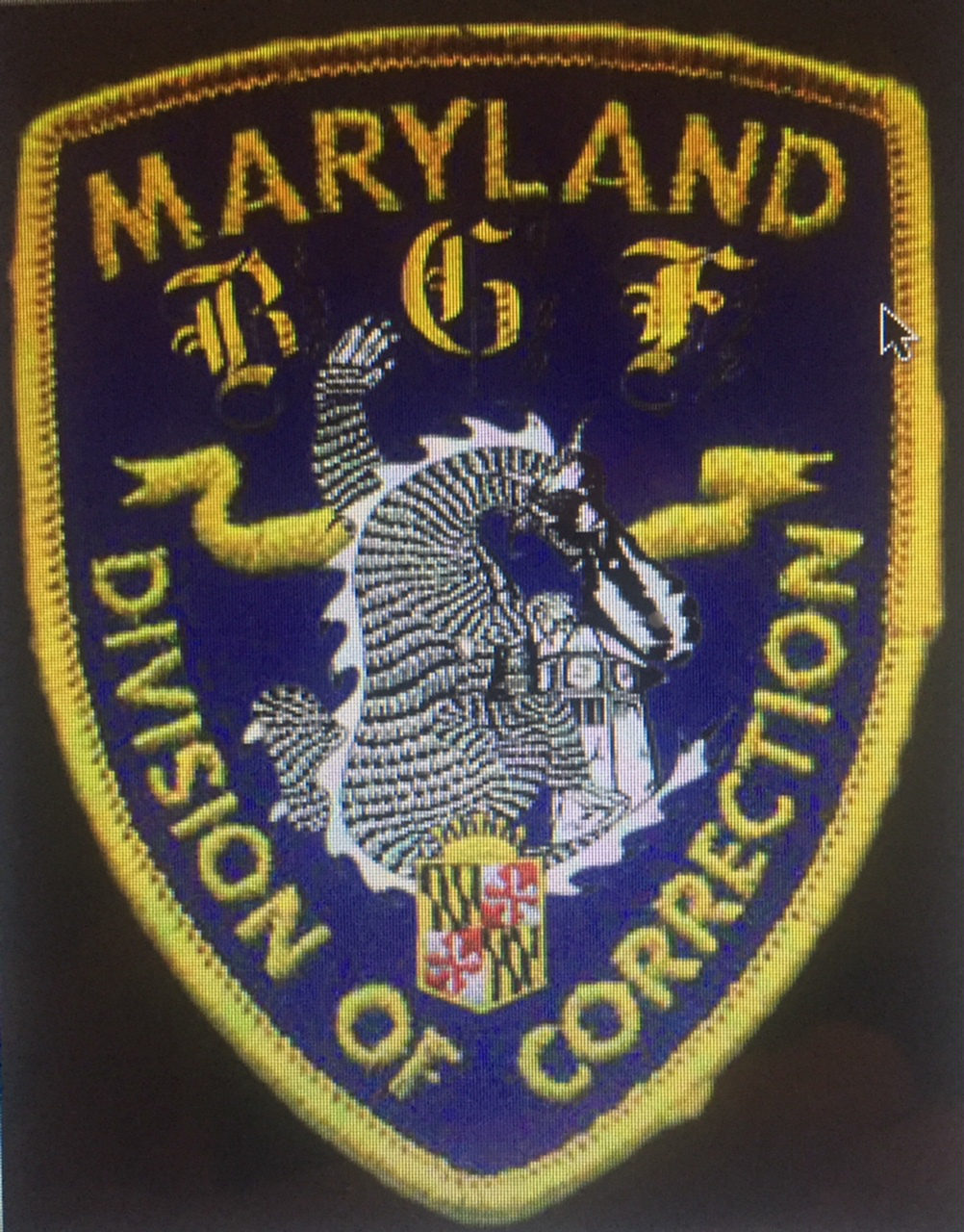By Van Smith
Published in City Paper, May 12, 2010 (Illustration by Mel Guapo)

At about 9 p.m. on March 8, 2009, Musheerah Habeebullah called Eric Brown to dish about people they know. Three things were notable about the call. First, Habeebullah was a correctional officer at the Metropolitan Transition Center (familiarly known as “the Pen”) where Brown was, and is, an inmate. Second, even though they were talking on cell phones, not prison landlines, the call was being recorded. Third, the people they discussed were fellow corrections officers (COs) and inmates in the Maryland prison system who were doing business together.
They got to talking about one inmate who had recently transferred to the Pen from another institution, where he had monopolized the market for smuggled goods among inmates. He was finding the prison economy at the Pen much more competitive.
“You know down there, there are so many people who doing shit, you know it’s impossible, it’s impossible to be the only one,” Habeebullah said of the Pen.
“Right, right, everybody going to get their thing on,” Brown responded.
Habeebullah said that at the inmate’s prior prison, only a small number of corrections officers helped smuggle goods to inmates–“like one on each shift that be really making moves.” But at the Pen, “you got like seven, eight people. Soon it’s the whole damn shift,” she continued, so how “is it possible for you to take over” as the only inmate with contraband for sale?
“You ain’t gonna be on top like you was down there,” she went on, “cause it’s too many horses. Too many ways” to bring in contraband.
“Yeah,” Brown agreed, “ain’t nobody going to be the only game in town. . . . They ain’t just gonna let a motherfucker take over.”
Habeebullah told Brown how she’d provided another inmate, nicknamed “Baby,” with smuggled cell-phone parts, and how other prison guards smuggle contraband for inmates, identifying four correctional officers (COs) by name.
Inmates are not supposed to have cell phones, and, obviously, COs are not supposed to smuggle contraband into prisons. Nor are they supposed to have relationships with inmates outside of the normal routine of their official duties. But based on this conversation–and many others that were intercepted by U.S. Drug Enforcement Administration Special Investigations Group (DEA-SIG) investigators as they built a drug-trafficking case against the Black Guerrilla Family (BGF) prison gang in Maryland, which Brown is alleged to head–contraband-smuggling by COs and extracurricular relationships between COs and inmates are rife in most Maryland prisons.
Habeebullah got caught. So did two other COs–Terry Robe and Asia Burrus–and a prison kitchen worker, Takevia Smith. They were among 25 defendants indicted by a federal grand jury in April 2009 for taking part in the BGF’s drug-dealing scheme; all later pleaded guilty to knowingly aiding the BGF by smuggling contraband, including cell phones. Robe, Burrus, and Smith are currently serving federal prison time, set to be released next year; Habeebullah awaits her sentence.
Last year’s BGF indictments were not alone in uncovering suspected or confirmed integrity issues among state corrections officers. Evidence has surfaced that a prison investigator was ordered to stop a probe into gang-affiliated COs; that a veteran CO shared a house and a bank account with a murderous Baltimore drug dealer; that COs have been running extortion schemes on behalf of gangs; that COs have been having sex and becoming pregnant with inmates; and that COs have smuggled drugs and cell phones into the prison system–including to a man awaiting trial for murder who had just learned whether or not his codefendant had given a police statement about the case. In a capital murder case over the killing of a CO, lawyers for the two inmates charged have maintained that the stabbing was over a contraband-smuggling ring among COs that the victim–who was nicknamed “Homeland Security” by inmates due to his by-the-book approach to his job–wouldn’t tolerate.
The list of recent CO scandals is long, but it only includes circumstances in which the details have reached the light of day through the courts. These instances may well point to more widespread problems, though the reality inside prison facilities–where fear, stress, the potential for violence, and power struggles among and between staff and inmates are part of the day-to-day grind, and where the flow of information is tightly controlled–is hard to gauge.
During the past year, City Paper has been contacted by COs concerned about corruption within their ranks, offering to help get the public a truer picture of the depth and breadth of the situation, but their fears over the potential for harm to themselves or their families got the better of them. Attempts to reach out to COs and other prison staff–outside of official channels, so they can speak freely on background–have gone nowhere.
But a December 2009 letter to City Paper from an inmate, responding to coverage of the BGF indictments, provided a shocking glimpse of the environment within one of the prison system’s facilities in Baltimore. (The writer’s name and place of incarceration will be withheld, to protect the inmate’s safety.)
“I just wanted to correct the thought that is was [sic] just Eric Brown and a few accomplices,” the inmate wrote of corruption inside prison walls, “because it’s bigger and more widespread than printed [in the paper].” The letter contended that “I can honestly say that I am a witness to the ‘BGF’ running the correctional system here in Baltimore. Seriously, there are some [sic] many correctional officers working here associated with either the ‘Bloods’ or ‘BGF,’ it almost tallies [sic] the inmate population. And what unnerves me is that they openly flaunt it.”
The letter explained that COs’ “tattoos of ‘stars’ on wrists, behind ears, on arms, necks, and even faces, ‘butterflies’ and ‘beetles,’ help to tell . . . [the] level of their affiliation. They offer sex, money, and drugs to ‘move’ up in their rank or affiliations. There really has not been a day that I have spent here, where these things are not witnessed. It amazes me how the older correctional officers turn a blind eye to these occurances [sic] . . . a thorough purging of this system and investigation is necessary immediately.”
Rick Binetti, director of communications for the Maryland Department of Public Safety and Correctional Service (DPSCS), urges that corruption problems be kept in perspective. “There is no systemic issue” with corruption among COs, he says. Despite overwhelming evidence of widespread problems, he asserts that “there is an ugly case here or there coming out, but it’s not necessarily all gang-related.”
Binetti points out that of the nearly 7,000 COs statewide, 70 were fired last year. Twenty of those firings were for fraternizing with inmates and another four were for possessing contraband. Currently, Binetti says, the department is investigating three COs for having contraband cell phones. Binetti adds that, under current law, firing COs can prove difficult due to a 30-day timeframe for completing an investigation into wrongdoing. “You can’t build a solid case in that amount of time,” he says.
Meanwhile, Binetti adds, “our efforts in identifying these gangmembers [who are COs] is so much better than it was three years ago. We’re figuring out who those people are, and they are getting the chop.” New state regulations put in place late last year by the Maryland Police and Correctional Officer Training Commission require that CO applicants answer specific questions about gang ties and that DPSCS background investigators scour law-enforcement gang databases to see if applicants are listed. “If there is any sort of gang affiliation in your background, you could be out,” Binetti says.
“The department is trying” to confront the integrity challenges among its staff, Binetti concludes, “and we’re doing a hell of a lot more than we were three or four years ago.”
Last November, to mark Terry Robe’s conviction for her role in the BGF drug-dealing conspiracy, DPSCS Secretary Gary Maynard issued a statement to buttress the case that the department is getting better–and succeeding–in combating gang influences and contraband smuggling in prisons. He noted that gang-intelligence efforts had yielded a 35 percent increase in identifying gang members among prison inmates, that improved security had yielded a one-third increase in the number of cell phones recovered from inmates (to a total of 1,658 in fiscal year 2009), and that 24 Body Orifice Security Scanners (highly sensitive metal detectors known as BOSS chairs) installed in the state’s prison facilities had provided new opportunities to detect and prevent contraband from getting in.
The department’s confidence in its anti-corruption efforts is bold, and it is getting legislative help. During this year’s General Assembly session in Annapolis, which ended in April, two bills addressing the hiring and firing of COs were passed and will soon be incorporated into departmental regulations.
One, House Bill 1402, entitled Public Safety–Preemployment Polygraph Examinations for Correctional Officer Applicants, allows DPSCS to order lie-detector tests to screen applicants. Already, Binetti says, nearly 70 percent of applicants–which number 4,000 to 4,500 per year–are rejected because they don’t pass the background check. Ordering polygraphs on a selective basis may make it even harder to gain employment as a CO.
The other bill, Senate Bill 887, Correctional Services–State Correctional Officers’ Bill of Rights, affords new protections and procedures for COs accused of wrongdoing. It was backed by unions representing COs, and Binetti says DPSCS also supported it. “It establishes procedures for correctional officers to be interrogated and investigated, and it gives them a trial board, like police officers have, when they are accused” he explains. A strong plus, he adds, is that it extends the 30-day period for conducting investigations to 90 days, allowing more thorough work before investigators have to either file formal charges or drop the case.
Patrick Moran, director of the American Federation of State, County, and Municipal Employees (AFSCME) in Maryland, praised the bill-of-rights measure on a number of fronts. “Correctional officers accused of wrongdoing are now innocent until proven guilty, just like the prisoners they are surrounded by every day,” he says. “It gives people solid due process, where they didn’t have that before.”
As for bad actors, Moran says the new bill-of-rights law won’t protect them if the evidence is tight. “The vast majority of correctional officers are honest, solid citizens, working in a very stressful environment unlike any other job in the world. But there are always exceptions to the rule, and those who are found to be corrupt ought to be dealt with roundly and sharply, because it affects everybody,” he says. Now, he adds, the department “will have more time to investigate those situations, so they’ll find the evidence if it’s there, and the wrongly accused will have their opportunity to fight the charges if it’s not there. Before, the department was prosecutor, judge, and jury all at once.”
The bill’s chief sponsor, state Sen. Donald Munson (R-Washington County), says his main concern in bringing the legislation was a troubling case of COs getting railroaded by the existing disciplinary process over charges of inmate abuse a couple of years ago. When asked how it will affect the department’s efforts to rid itself of gang-tied COs assisting inmates in criminal schemes, Munson says, “I’ve never thought of this measure in this context. My guess is that the correctional officers who are going to be judges are going to be very hard on those cases.” He adds, “If it doesn’t work, we’ll fix it in the future.”
Robert Walker, a veteran law enforcer whose long career began as a correctional officer with the Maryland Department of Corrections in the 1950s, knows a thing or two about gangs and corrupt COs. After leaving Maryland, he began a decades-long career in federal law enforcement (including for the DEA). He retired to return to prison work in the South Carolina penal system, doing internal investigations and running the gang unit, where he developed a gang identification and tracking system in order to monitor inmates. Today, he is a gang consultant, serving as an expert witness in trials and teaching law enforcers and prison personnel the ins and outs of gangs.
Walker is a strong supporter of COs, and, just as strongly, has antipathy for corrupt ones. When told that Maryland is grappling with CO integrity problems, he says, “I hope they are really going into heavy penalties for that. To turn to the other side and try to make a buck is truly outrageous. You have got to have some honest people–and most of them will be honest. There are maybe 10, 15 percent, at the most, who are on the other side.” Given the litany of revelations about CO corruption coming out of Maryland courts, though, he adds, “I may have to change my assessment of the percentage . . . the worst thing that can happen is to engage in denial, because that means the problem will get bigger and bigger.”
As for the proposed reform measures, Walker likes them all–except for the selective pre-employment polygraph law, which he believes should be universal, not only among prospective COs, but among all staff. To save money, he says the state should hire its own polygraph examiners and lie-detecting equipment. “With so many concerns about so much wrongdoing, you have got to find the money to do it right,” he says.
Whether DPSCS’ ongoing efforts to combat corruption will have any significant effect will become evident as time passes. In the meantime, integrity cases keep popping up.
In February, two COs were arrested, one in Western Maryland and another in Baltimore City. In the Western Maryland case, Correctional Dietary Officer Justin Wayne Smith was caught trying to bring a balloon filled with heroin and a syringe to an inmate at the maximum-security Western Correctional Institution in Cumberland. In Baltimore, CO Shanika Johnson’s bag was searched as she entered the Baltimore City Detention Center and was found to contain an ounce of marijuana and two cell phones. She told investigators that an inmate, who she refused to name, was going to pay her $1,000 for delivering the contraband.
A serious case was brought against CO Lynae Chapman in October 2009. The father of her unborn child, BGF member and murder suspect Ray Donald Lee, was detained pending trial at the Baltimore City Detention Center when his prison cell was searched in late September, turning up marijuana, tobacco, and a cell phone that investigators quickly determined had been procured by Chapman. When confronted about the phone, Chapman promptly confessed to delivering it to Lee. At the time, discovery in Lee’s murder case had reached the point when he would learn whether or not his codefendant, Quinard Henson, had given a statement to police. Recovering the phone Chapman had provided Lee may have forestalled the potential for Lee to use it to arrange for retaliating against Henson. Chapman is scheduled for a June trial, after having been re-indicted in March for misconduct, contraband delivery, and–with Lee as her codefendant–drug dealing.
Also last fall, a federal civil-rights case brought against CO Antonia Allison by inmate Tashma McFadden brought to light DPSCS internal documents, supported by depositions, showing that a prison investigator, Santiago Morales, had developed evidence in 2006 and 2007 of 16 COs at the BCDC who had gang ties. Morales had named the 16 COs in written reports to BCDC’s warden at the time, William Filbert, who promptly ordered him to stop writing the reports.
McFadden’s case alleges that Allison is a Bloods gang member, and that, after a verbal argument with McFadden, she unlocked his cell to allow fellow Bloods members who were inmates to attack him, resulting in 32 stab wounds. Allison, who is represented by the Maryland Attorney General’s Office, denies the allegations. Recent activity in the case includes a motion by the defense to keep jurors from hearing testimony about Allison’s alleged gang ties, as well as Morales’ suspicions of gang-tied COs.
Meanwhile, McFadden’s attorney, Aaron Casagrande, on Apr. 27 filed a motion to re-open discovery in the case. The reason, the motion explains, is that McFadden was recently put in administrative segregation at the Eastern Correctional Institution to protect him because other inmates there, who are Bloods members, have ordered him murdered for bringing the case against Allison. Attached to the motion is an inmate’s letter that alleges McFadden’s murder has been ordered and describes Allison as “doing right by us . . . all she asked from her brothers was to keep her safe . . . that’s what we did.”
Nothing beats last year’s BGF case in federal court for suggesting that dirty COs are a major and ongoing problem for the DPSCS. Habeebullah, Robe, Burrus, and Smith may have been indicted and convicted, but the evidence in the case includes troubling references to other COs in on the gang-related action.
One of the DEA’s sources for building the BGF case provided details of a BGF extortion scheme that relies on the assistance of corrupt COs. The scheme–similar to a case from 2007 involving a former CO, Fonda White, who also pleaded guilty–was described in a lengthy affidavit.
“Several guards with the Department of Corrections are assisting BGF members with an extortion scheme under which BGF offers ‘protection’ while in jail to newly arrested persons who are not BGF members,” the affidavit states. It continues:
In exchange for this “protection,” an arrested person is required to pay money to BGF. Specifically, BGF supplies the person to be protected with a credit card number of a prepaid credit card (sometimes referred to as a “Green Dot” card), and the person to be protected is required to have family members or friends place money onto the card when periodically directed to do so by BGF. The credit card is often held by one of the corrections officers who are assisting BGF or by BGF members on the street. The credit card is then used to pay for items for BGF members. If the newly arrested inmate does not agree to pay for the “protection,” then he or she is targeted for violent crimes while in prison.
The affidavit also describes CO corruption at the Supermax, as described in intercepted cell phone conversations among inmates. Eric Brown, on the same day he spoke with Habeebullah about COs smuggling at the Pen, talked on a cell phone with a Supermax inmate, Melvin Gilbert, who was awaiting a federal trial on charges of drug-dealing and murdering a witness. They discussed the difficulties they were facing in getting contraband cell phones due to a crackdown by prison authorities. Though Brown had been able to get three phones recently, there were still “holes”–meaning dirty COs–to be discussed.
“If we don’t open a hole up by the end of this month, it probably don’t be no more than about 20 phones left in this motherfucker. I’m telling you. They’re tearing our ass up, Melvin,” Brown said.
“Yeah, they heavy over here, too,” Gilbert responded.
Later in the conversation, Gilbert asked Brown if he knew a CO named “Simmons,” and Brown said he did. “Man,” Gilbert said, “holler at that bitch for us. She over here [at the Supermax] and she working, but she’s staying away from me.” Gilbert complained that “Simmons” was instead doing favors for other inmates, whom Gilbert called “low budget.” Then Gilbert talked about another CO he thought was smuggling contraband into the Supermax, and another who was carrying his child. This last CO, Gilbert said, was suspected of snitching on inmates and had been threatened for it recently, but Gilbert said he told her: “Don’t you ever call me and tell me, like, you’re worried about another motherfucker. Them niggers be bluffing. I’m not a bluffer. I’m the one that you gotta worry about.”
Later last year, Gilbert was convicted on drug-dealing, witness murder, and other murder charges, and was sentenced to life in prison. He is currently housed at the high-security United State Penitentiary–Canaan, in Northeast Pennsylvania.
What Gilbert and Brown were discussing–and what facts in other corrupt-CO cases describe–suggest a prison culture where COs smuggling for inmates, having sex with them, and having other inappropriate contact with them are a given. However, as Gilbert and Brown noted, a crackdown on cell-phone smuggling was working–and still is, according to Binetti, who points out that “we may have a reached a tipping point” since fewer cell phones are being found in prisons this year than in prior years. If a bill currently before the U.S. Congress passes, allowing prison systems to employ cell-phone jamming technology, any phones that remain may become useless.
But perhaps the best indicator that DPSCS’ attempts to thwart corruption are taking hold is the most recent federal indictment of alleged BGF drug dealers: No COs were among the defendants in the case, indicted in mid-April, which was built on a continuing investigation from last year’s indictments. That’s not to say the new BGF case doesn’t reference CO corruption, though.
In a Feb. 18 conversation that DEA investigators intercepted between one of the defendants, Duconze Chambers, and a drug dealer known as “Chips,” reveals that Chambers knows a CO at Brockbridge Correctional Facility that could smuggle something in for Chips’ cousin, Bug, who’s an inmate there. Other than that, the only evidence in the case so far is that one of DEA’s sources gave up a cell phone number for a “female correctional officer” said to be “an active BGF member.”
If that’s all the DEA-SIG investigators turned up this time around, well, that’s improvement over last year. One has to wonder, though, if such a problem can be eradicated so quickly.
Share this:- Share





